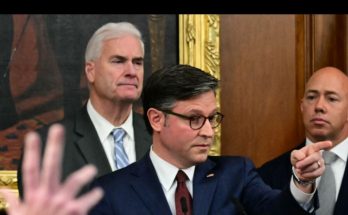Former Capitol Police Chief Steve Sund publicly disputed former Speaker Nancy Pelosi’s account of events surrounding the January 6, 2021, Capitol riot, releasing a detailed timeline that questions her office’s handling of National Guard deployments. Sund’s statements, made on Wednesday, cast a spotlight on conflicting narratives about the preparedness and response of Congress’s security apparatus during one of the most turbulent days in recent U.S. history.
The confrontation followed a tense exchange earlier Wednesday when Pelosi was approached by Lindell TV reporter Alison Steinberg outside the Capitol. Steinberg pressed Pelosi about her role in the delay of National Guard support as rioters stormed the building. Pelosi sharply denied any refusal to deploy the Guard, stating, “SHUT UP! I did not refuse the National Guard. The President didn’t send it. Why are you coming here with Republican talking points as if you are a serious journalist?”
Despite Pelosi’s strong rebuttal, Steinberg continued to press for answers, citing public interest and accountability. Pelosi, however, attributed the responsibility for the delayed response to former President Donald Trump, asserting that the lack of immediate National Guard support was not a result of actions taken by her office.
Sund’s Timeline and Allegations
In response, Sund posted a detailed statement on X, directly challenging Pelosi’s claims. He asserted that his multiple requests for National Guard assistance were repeatedly denied by the Speaker’s Sergeant at Arms (SAA), both before and during the events of January 6. Sund indicated that on the day of the riot, his urgent requests were denied for more than 70 minutes while the SAA “ran it up the chain” for Pelosi’s approval.
“Ma’am, let me help refresh your memory,” Sund wrote, addressing Pelosi. “It was your Sergeant at Arms who repeatedly denied my multiple requests for National Guard assistance before and on January 6. Even on Jan 6, your Sergeant at Arms denied my urgent requests for over 70 minutes, while he was ‘running it up the chain’ for your approval.”
Sund also emphasized that the Pentagon had offered immediate support, but he lacked the legal authority to accept it without the proper authorization from congressional leadership, as mandated under federal law (2 U.S.C. §1970). According to Sund, these denials significantly hampered the Capitol Police’s ability to respond effectively to the escalating violence.
Context of the January 6 Riot
The January 6 attack on the U.S. Capitol, which sought to disrupt the certification of the 2020 presidential election, resulted in multiple deaths, hundreds of injuries, and widespread damage to the Capitol complex. Investigations have examined failures in security protocols, including delays in mobilizing additional law enforcement and National Guard support.
In the aftermath, several investigations—including those conducted by congressional committees—have focused on the chain of command for security decisions. Sund’s recent statements highlight tensions between Capitol Police leadership and congressional offices regarding responsibility for timely deployment of reinforcements.
Conflicting Narratives
Pelosi has consistently defended her office’s handling of the events, asserting that her team acted within the limits of authority and protocol. However, Sund’s account suggests that bureaucratic obstacles within her office may have contributed to delays in critical support. This divergence raises questions about how much authority congressional leaders have over security forces and how decisions were communicated on that day.
Analysts note that the situation on January 6 involved overlapping chains of command, with the Capitol Police, the Sergeant at Arms, and the Pentagon all playing roles. The coordination of National Guard deployments requires approval from congressional leadership, which means delays in communication can have serious operational consequences. Sund’s timeline implies that such delays may have exacerbated the vulnerability of Capitol personnel during the riot.
Public and Political Reactions
Sund’s public statements have quickly attracted attention, reigniting debate over accountability for January 6. Some commentators argue that his timeline provides critical clarity regarding the legal and procedural barriers that hindered immediate response. Others suggest that the dispute reflects the broader political tensions surrounding the event, where competing narratives are often shaped by partisan perspectives.
Democratic leaders have defended Pelosi, emphasizing that the extraordinary circumstances on January 6 created challenges for all agencies involved. Meanwhile, some Republican lawmakers have cited Sund’s statements as evidence that congressional leadership could have acted more decisively to deploy reinforcements.
Legal Considerations
Federal law (2 U.S.C. §1970) outlines the conditions under which the Capitol Police Chief may request assistance from the National Guard. Sund has maintained that while he had urgent operational needs, he could not unilaterally authorize the deployment without approval from congressional authorities. This legal framework has become a focal point in assessing responsibility for the security failures on January 6.
Legal experts suggest that Sund’s timeline could be relevant for ongoing investigations and hearings related to January 6. By documenting the specific sequence of requests and denials, Sund provides a record that contrasts with Pelosi’s statements, potentially informing future reviews of congressional security protocols.
Implications for Historical Record
The clash between Sund and Pelosi underscores the continuing struggle over the historical narrative of January 6. Accurate accounts of events are critical for evaluating systemic failures and implementing reforms to prevent similar crises in the future. Sund’s timeline adds detail to the chronology of the day, illustrating the difficulties faced by law enforcement in navigating procedural and bureaucratic barriers.
Observers note that the exchange also reflects broader questions about accountability in federal institutions. While political leaders shape policy and oversight, law enforcement officers on the ground face real-time decisions that can determine life-and-death outcomes. Understanding how these dynamics played out on January 6 is central to evaluating lessons learned.
Moving Forward
As the debate over January 6 continues, Sund’s public challenge to Pelosi may prompt further scrutiny of congressional security procedures and decision-making protocols. Both the Sergeant at Arms and congressional leadership are likely to face renewed examination regarding their actions and communications leading up to and during the riot.
Sund’s statements also highlight the importance of clearly defined authority and procedures for emergency situations in the Capitol. Lawmakers and security officials may be prompted to review existing regulations to ensure that rapid response is possible in future crises, minimizing reliance on potentially slow or convoluted chains of approval.
Ultimately, the dispute between Sund and Pelosi illustrates the complex interplay between political leadership, law enforcement authority, and emergency response. By presenting a detailed account of his actions and the obstacles faced, Sund has contributed to a growing public record that seeks to reconcile conflicting narratives about one of the most consequential events in modern U.S. history.


